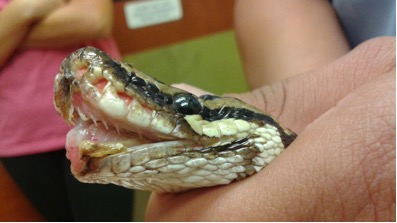Compounded enrofloxacin in reptile species
Compounded enrofloxacin in reptile species
Enrofloxacin is a synthetic antimicrobial prescribed in disease states involving susceptible bacteria like Staphylococcus, Proteus, Escherichia coli, Pasteurella, Klebsiella and Pseudomonas aeruginosa. (4) The drug acts by inhibiting DNA and RNA synthesis within the pathogen. In most of our patients, it is metabolized to ciprofloxacin, which may contribute to additional antibacterial effects. In reptiles, it is mostly used in upper respiratory infections, wounds, abscesses and critically ill individuals. For example, this python (see figure 1) has facial lesions from self-induced trauma after some components of the enclosure materials were changed from plastic to wood. The patient also presented with upper respiratory congestion, which was noticed during the physical examination as a harsh upper nasal noise. Other than the presented symptoms, the python was behaving and eating normally. After discussing with the client every aspect of environmental modification to prevent the problem from recurring, I recommended enrofloxacin intramuscular injections in the first (cranial) 1/3 of the python’s body at 5 mg/kg every 3 days (q 36 hours) until lesions improved. After the second injection, lesions started to visually disappear and no side effects were reported. In my experience, this antimicrobial is a great option for fast healing of skin wounds in reptile patients. But, on occasions, some patients may develop topical side effects to the medication.
In the USA, enrofloxacin is commercially available in the injectable form and tablets approved by the FDA for dogs and cats (1). However, in reptiles and other exotic species, the tablet formulations might not be as palatable, easy to administer and can potentially cause oral ulcerations. Furthermore, with the injectable form, the patient may develop site intramuscular pain, tissue necrosis, skin discoloration or sterile abscesses (2, 3). These are reported cases where some exotic animals have developed hypersensitivities to the drug, which defeats the therapeutic purpose (3). Due to these problems and the need to provide treatment, compounding formulations of oral enrofloxacin can be offered as an alternative. The goal of compounding medications is to effectively deliver the drug and mitigating or at least decreasing side effects while keeping the therapeutic benefits offered by the original drug.
We, as veterinarians, are presented with the constant challenge of treating not only snakes but also lizards, frogs and other exotic species. Definitely one size does not fit all. So when designing a compounded medication, the flavoring vehicle (for example: cricket flavor) is considered as well as trying to minimizing the adverse effects from the mixture between the flavoring ingredient and the therapeutic drug. A specialized pharmacy can help you take into consideration many of those factors and find the best custom-made medication or formulation for your pet. Veterinary professionals do turn to a specialized compounded pharmacy when creating these medications. Talk to your veterinarian about compounded medication options.

Figure 1: Self-induced cage trauma on a python. This patient was treated with enrofloxacin injections every 3 days.
References:
1) FDA U.S. Food and Drug Administration. Animal Drugs @ FDA. Available at http://www.accessdata.fda.gov/scripts/animaldrugsatfda/index.cfm?gb=2 Accessed April 14, 2016.
2) Olivia A. Petritz, David Sanchez-Migallon Guzman, Valerie J. Wiebe, and Mark G. Papich Stability of three commonly compounded extemporaneous enrofloxacin suspensions for oral administration to exotic animals. Journal of the American Veterinary Medical Association, July 1, 2013, Vol. 243, No. 1, Pages 85-90
3) Douglas R. Mader, MS, DVM, DABVP. Reptile Medicine and Surgery. Saunders; 2 edition. December 27, 2005. Section V page 643 and 649-651 ISBN: 978-0-7216-9327-9
4) Papich, Mark G. Saunders Handbook of Veterinary Drugs: Small and Large Animal. 3rd Edition. Elsevier. 2011. Page 278-280.
Dr. Joanne Fernandez-Lopez is a small animal veterinarian graduated from North Carolina State University in 2014. She has been working at a small animal general practice in the South Miami Area. Recently, she accepted a position at a Small Animal Internal Medicine and Surgical internship in West Florida to pursue specialization. Her interests are dermatology, surgery, emergency medicine, exotic animal medicine, marine biology and research.



Comments